This is the Saint Louis Science Center’s NIGHT SKY UPDATE for the week of Friday, February 19, 2021.
Information updated weekly or as needed.
Times given as local St. Louis time which is Central Standard Time (CST). For definitions of terminology used in the night sky update, click the highlighted text. If relying on times posted in Universal Time (UT), St. Louis is now -6 Hours from UT.
Public Telescope Viewings
Star parties at the Saint Louis Science Center have temporarily been canceled due to recommendations from the CDC regarding COVID-19. All public telescope events are canceled until further notice. As conditions change, we will reevaluate and update this article once public observing events resume.
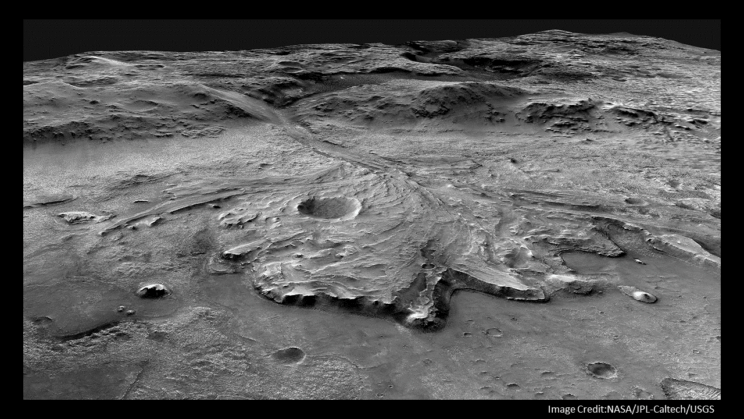
Illustrated View of Perseverance Landing Site Inside Jezero Crater
Credit: NASA/JPL -Caltech/USGS
Observing Highlight of the Week
We are sticking with Mars this week to update the landing of NASA’s newest Mars rover Perseverance. On February 18, 2021, Perseverance landed successfully on Mars in Jezero crater. Before the rover starts its two-year mission, it will undergo several weeks of testing. NASA’s Mars Exploration Program website will be a good resource to visit each day to find any updates on the rover and its mission. Aside from information about Perseverance, NASA’s website will keep you up to date on any new findings from other Mars missions and research.
The first images to be sent by the rover are from hazard cameras on the Rover taken after it landed. These are far from what we should expect to see as the mission begins but they are a great start. As a preview of what we have to look forward to, check out this zoomable image from the rover Curiosity.
The Perseverance will see the rover study rock and sediment of an ancient lakebed and river delta which will help characterize the regional geology and climatic past. Additionally, Perseverance will have a focus on astrobiology which will help determine if Mars ever had conditions suitable for life. We have a lot to look forward to from Perseverance but for now we can enjoy its first views from the surface of Mars. Below you will find a few of the first images sent back to Earth from Perseverance.
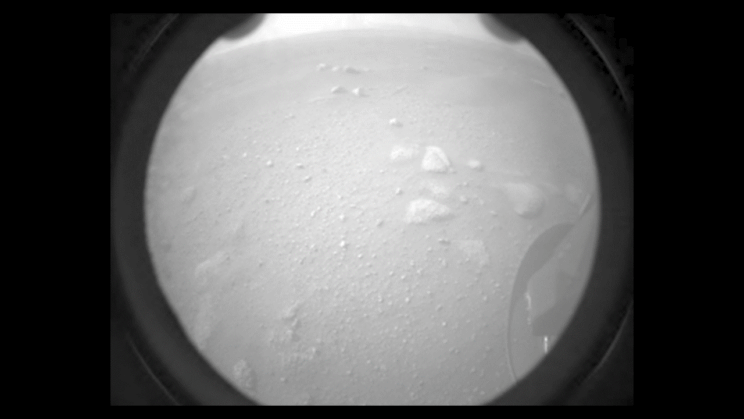
View Perseverance of Landing Site from Hazard Camber
Credit: NASA/JPL -Caltech
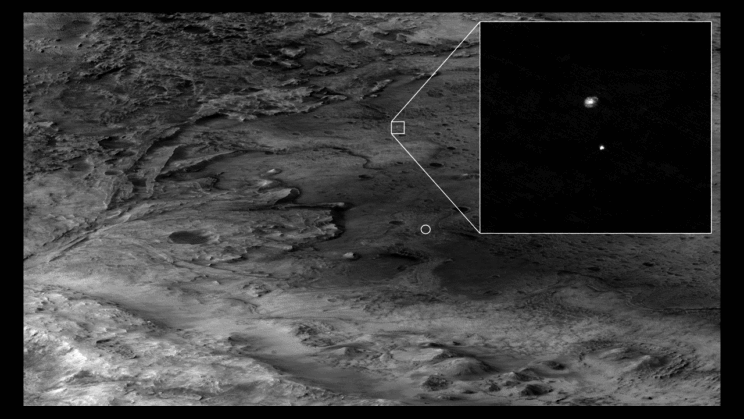
View of Perseverance During Decent Stage Captured by HiRISE
Credit: NASA/JPL -Caltech/University of Arizona
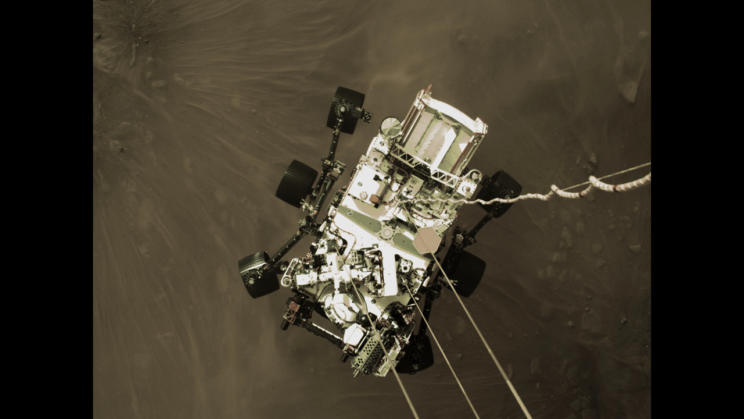
Still Image of Perseverance from the Decent Stage While Rover was being Lowered to Martian Surface
Credit: NASA/JPL -Caltech
The Sun and Moon

The Moon as seen from the International Space Station, on July 31, 2011.
Credit: NASA
Sunrise is at 6:47 a.m. on Friday, February 19 and sunset is at 5:44 p.m. providing us roughly 10.5 hours of daylight. Even after sunset, the light from the Sun will dimly illuminate our sky for about 1 hour and 30 minutes. This period is called twilight, which ends around 7:13 p.m. this week. For those with a sundial, local noon occurs around 12:15 p.m. this week.
| Day | Sunrise | Sunset |
|---|---|---|
| 2021-02-19 | 6:47 a.m. | 5:44 p.m. |
| 2021-02-20 | 6:45 a.m. | 5:45 p.m. |
| 2021-02-21 | 6:44 a.m. | 5:46 p.m. |
| 2021-02-22 | 6:43 a.m. | 5:47 p.m. |
| 2021-02-23 | 6:41 a.m. | 5:48 p.m. |
| 2021-02-24 | 6:40 a.m. | 5:49 p.m. |
| 2021-02-25 | 6:39 a.m. | 5:50 p.m. |
| 2021-02-26 | 6:37 a.m. | 5:51 p.m. |
| 2021-02-27 | 6:36 a.m. | 5:52 p.m. |
Moon
Moonrise for Friday, February 19 occurs at 10:53 a.m. and moonset will occur at 1:34 a.m. on the follow day. On Friday, February 19 the Moon will exhibit a waxing gibbous phase with 52% of the lunar disk illuminated. Full moon occurs on February 27 at 2:17 a.m.
International Space Station (ISS) Observing

Visible passes of ISS from St. Louis for the week of February 19 occur during morning hours. The best passes this week occur on the mornings of February 20 and 21. Use the table below for information about these and other visible passes this week.
Catch ISS from St. Louis starting Friday, February 19
| Date | Starts | Max. altitude | Ends | |||||||
|---|---|---|---|---|---|---|---|---|---|---|
| Time | Alt. | Az. | Time | Alt. | Az. | Time | Alt. | Az. | ||
| 20 Feb | -1.1 | 04:41:48 | 15 | SSE | 04:42:41 | 16 | SE | 04:44:48 | 10 | E |
| 20 Feb | -3.5 | 06:15:55 | 10 | WSW | 06:19:12 | 50 | NW | 06:22:29 | 10 | NE |
| 21 Feb | -3.9 | 05:30:01 | 26 | SW | 05:31:45 | 88 | NW | 05:35:08 | 10 | NE |
| 22 Feb | -2.6 | 04:45:00 | 43 | E | 04:45:00 | 43 | E | 04:47:39 | 10 | ENE |
| 23 Feb | -2.8 | 05:32:48 | 26 | WNW | 05:33:47 | 31 | NNW | 05:36:50 | 10 | NE |
| 24 Feb | -2.3 | 04:47:29 | 31 | NNE | 04:47:29 | 31 | NNE | 04:49:33 | 10 | NE |
| 25 Feb | -1.8 | 05:35:01 | 15 | NW | 05:36:00 | 16 | NNW | 05:38:13 | 10 | NNE |
| 26 Feb | -1.6 | 04:49:30 | 18 | N | 04:49:30 | 18 | N | 04:51:02 | 10 | NNE |
Magnitude (Mag): The Measure of brightness for a celestial object. The lower the value is, the brighter the object will be.
Altitude (Alt): The angle of a celestial object measured upwards from the observer’s horizon.
Azimuth (Az): The direction of a celestial object, measured clockwise from an observer’s location with north being 0°, east being 90°, south being 180° and west being 270°.
For information about ISS flyovers and other visible satellites, visit www.heavens-above.com
Detailed information regarding all unmanned exploration of our universe, missions past, present, and planned, can be found at Jet Propulsion Laboratories:
The Visible Planets
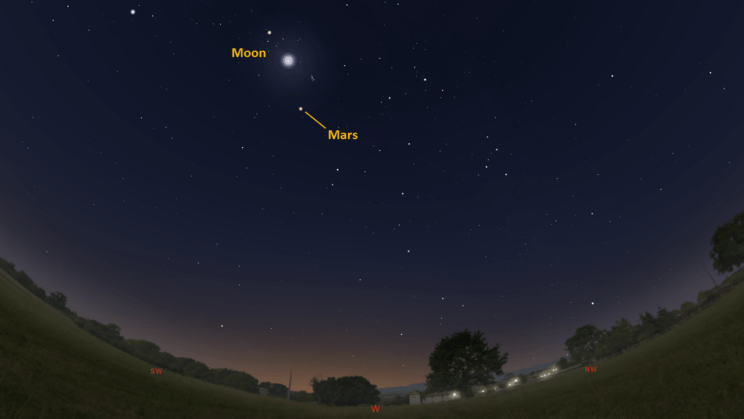
Looking West, at 6:30 pm, February 19, 2021
Credit: Stellarium, EG,
This week, one naked eye planet is visible. Mars is found high in the south after sunset. At the end of February, Saturn, Jupiter and Mercury will join the morning sky just before sunrise. This morning apparition for Mercury will not be great but the trio will make for a challenging grouping to look for at the end of the month.
Mars
Currently Mars appears as a 0.8-magnitude object that will be visible high in the south about 30 minutes after sunset. Mars sets by 12:28 a.m. The observing season for this apparition ends around March 10, 2021 and superior conjunction occurs on October 7, 2021.
Uranus
Uranus is not a planet we normally include in this section. Even at its dimmest, the giant planet does hover within naked eye visibility. That said, it is so close to the visible limit of the human eye it just is not reality for most of us to see Uranus without binoculars or a telescope. You can find Uranus in the constellation Aries the Ram. The current magnitude for Uranus is 5.8. A finder chart for Uranus can be found here.
James S. McDonnell Planetarium
Night Sky Update: February 19-February 27, 2021






